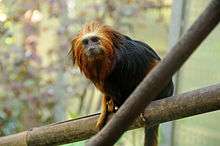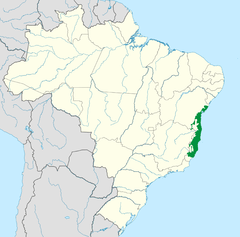Bahia coastal forests
| Bahia coastal forests | |
|---|---|
|
| |
|
Localization of Bahia coastal forests ecorregion as delineated by WWF. | |
| Ecology | |
| Biome | Atlantic Forest |
| Borders | Serra do Mar coastal forests, Bahia interior forests and Pernambuco coastal forests |
| Bird species | 466[1] |
| Mammal species | 166[1] |
| Geography | |
| Area | 109,815 km2 (42,400 sq mi) |
| Country |
|
| States | Bahia and Espírito Santo |
| Conservation | |
| Habitat loss | 95.0%[2] |
| Protected | 1.78%[1] |
The Bahia coastal forests are a tropical moist broadleaf forest ecoregion of eastern Brazil, part of the larger Atlantic Forest region.
Setting
The Bahia coastal forests occupy a belt approximately 150 km (93 mi) wide along the Atlantic coast of eastern Brazil, in the states of Bahia and Espirito Santo. The Itapicuru River forms the northern boundary of the ecoregion, which extends south to near the Itapemirim River. The ecoregion is bounded on the east by the Atlantic Ocean and the enclaves of the Atlantic Coast restingas forests and Bahia mangroves. To the west, the forests transition to the drier Bahia interior forests.
The forests cover Tertiary sedimentary plateaus extending from near the seacoast westward to the lower slopes of the Serra da Mantiqueira. The prevalent soils are tropical nutrient-poor yellow-red latosol and podzols.
Climate
The ecoregion has a tropical climate with annual rainfall ranging from 1,200 to 1,800 mm, evenly distributed throughout the year. The southern portion of the ecoregion may experience a dry period from May through September.
Flora
The four-tiered Atlantic evergreen moist forests are the predominant vegetation type.
Fauna


Endangered mammals in the ecoregion include the maned three-toed sloth (Bradypus torquatus) and golden-headed lion tamarin (Leontopithecus chrysomelas).
Conservation and threats
Less than 5% of the original forest cover remains intact. Protected areas in the ecoregion include Sooretama Biological Reserve and Linhares Forest Reserve.
References
- 1 2 3 Hoekstra, J. M.; Molnar, J. L.; Jennings, M.; Revenga, C.; Spalding, M. D.; Boucher, T. M.; Robertson, J. C.; Heibel, T. J.; Ellison, K. (2010). Molnar, J. L., ed. The Atlas of Global Conservation: Changes, Challenges, and Opportunities to Make a Difference. University of California Press. ISBN 978-0-520-26256-0.
- ↑ Viana, V. M., A.J. Tabanez, and J.L. Batista. 1997. Dynamics and restoration of forest fragments in the Brazilian Atlantic moist forest. Pages 351-365 in W.F. Laurance, and R.O. Bierregaard Jr, editors, Tropical forest remnants: ecology, management, and conservation of fragmented communities. University of Chicago Press, Chicago.
- "Bahia coastal forests". Terrestrial Ecoregions. World Wildlife Fund.
- World Wildlife Fund (2001). "Bahia coastal forests". WildWorld Ecoregion Profile. National Geographic Society. Archived from the original on 2010-03-08.

